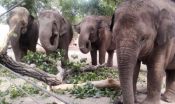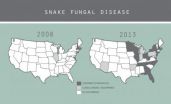(Press-News.org) CHAMPAIGN, Ill. — Mycobacterium tuberculosis, the organism that causes tuberculosis in humans, also afflicts Asian (and occasionally other) elephants. Diagnosing and treating elephants with TB is a challenge, however, as little is known about how their immune systems respond to the infection. A new study begins to address this knowledge gap, and offers new tools for detecting and monitoring TB in captive elephants.
The study, reported in the journal Tuberculosis, is the work of researchers at the University of Illinois Zoological Pathology Program (ZPP), a division of the veterinary diagnostic lab at the College of Veterinary Medicine in Urbana-Champaign. ZPP is based in Chicago, serving zoos and wildlife in the region and beyond.
More than 50 elephants in captivity in the U.S. have been diagnosed with tuberculosis since 1994, the research team reports. The evidence suggests that humans can transmit the disease to elephants and that elephants also may serve as a source of exposure for humans.
When infected, elephants may appear healthy or only show general symptoms, such as weight loss, that could be associated with a variety of maladies, said Jennifer Landolfi, a veterinary pathologist who led the new research. Most cases are found as a result of routine tests which involve checking the blood for antibodies against TB, or collecting samples from an elephant's trunk and culturing the bacteria it harbors.
But these approaches are problematic, Landolfi said. Culturing mycobacteria takes time and is imprecise, while antibody responses may take weeks to develop and only indicate exposure, not necessarily infection or disease.
"We are always trying to improve and seek out new diagnostics that will allow for earlier, more accurate detection of this infection," she said. "We also need to find ways to monitor the treatment response."
In humans, exposure to tuberculosis rarely results in full-fledged disease. Most people's immune systems eradicate the bacterium or at least keep the disease at bay, Landolfi said.
"Less than 10 percent of the people who are exposed actually develop the disease," she said. In those cases, an inadequate immune response is almost always to blame. "Our hypothesis is that something similar is happening in the Asian elephants."
To test this, Landolfi and her colleagues looked at protein mediators that are part of an elephant's immune system. These small signaling molecules, called cytokines (SIGH-toe-kines), spur a cascade of cellular reactions that help the body fight infection. But detecting cytokines in elephants is difficult because antibodies that target elephant cytokines are not available.
"Instead of trying to detect the cytokines using antibodies, we said, 'why don't we take a step back and detect the nucleotides that code for those proteins?'" Landolfi said. "We're talking about messenger RNA (mRNA), which is used by the cell to synthesize these proteins."
After developing the tools to detect cytokine mRNA in elephants, the researchers collected blood from 8 TB-positive and 8 TB-negative Asian elephants, and isolated the white blood cells. They exposed the cells to proteins associated with TB and then analyzed the cell culture for expression of certain cytokines.
Their analysis showed that TB-positive and TB-negative elephants differed in their immune responses after exposure to TB bacterial proteins.
"The cytokines were at higher levels in the positive animals," Landolfi said. "That suggested that those animals had more of an immune reaction when they were exposed [to proteins associated with TB] than the animals that were negative."
If confirmed in future studies, the findings suggest a faster and more reliable way to diagnose TB in captive elephants, Landolfi said. The same kinds of tests are already used in humans.
"That is something that we want to move towards with elephants," she said. "Most of the elephants don't show us a lot of signs of disease, and even when they do appear to be sick, it's very non-specific."
This makes it difficult to diagnose them and to determine if treatment is working, she said. Having a new way to monitor the elephants' immune response would improve both tasks, she said.
INFORMATION:
Editor's notes: To reach Jennifer Landolfi, call 708-216-1185; email landolfi@illinois.edu.
The paper, "Differences in immune cell function between tuberculosis positive and negative Asian elephants," is available online or from the U. of I. News Bureau.
Team studies immune response of Asian elephants infected with a human disease
2014-07-15
ELSE PRESS RELEASES FROM THIS DATE:
Protein's 'hands' enable bacteria to establish infection, research finds
2014-07-15
MANHATTAN — When it comes to infecting humans and animals, bacteria need a helping hand.
Kansas State University biochemists have found the helping hand: groups of tiny protein loops on the surface of cells. These loops are similar to the fingers of a hand, and by observing seven individual loops on the surface of E. coli bacterial cells, the researchers found that the loops can open or close to grab iron in the environment.
"These structures are like small hands on the surface of bacterial cells," said Phillip Klebba, principal investigator and professor and head of ...
4 lessons for effective, efficient research in health care settings
2014-07-15
Thousands of studies take place every year in healthcare settings. A report published recently in the American Journal of Preventative Medicine describes how to do many of these studies more rapidly. By taking into account the real-world constraints of the systems in which providers deliver care and patients receive it, researchers can help speed results, cut costs, and increase chances that recommendations from their findings will be implemented.
The lessons come from the My Own Health Report project, a collaboration between seven research institutions with the goal ...
Mormon pioneer mortality rate calculated at 3.5 percent
2014-07-15
The final stanza of the Mormon pioneer anthem "Come, Come Ye Saints" directly confronts the prospect of dying on the trail: "And should we die, before our journey's through…"
Now new research shows that pioneer mortality rates were not much greater than national averages at the time.
This may come as a surprise to modern Mormon youth who've participated in handcart treks.
"The youth go out and learn that a lot of people died and they push the handcart and after three days they think they are practically dead," said retired historian Mel Bashore. "But most people traveled ...
Saltier intravenous fluids reduce complications from surgery
2014-07-15
(PHILADELPHIA) -- Adequate hydration via a saline drip is essential during surgery, but recent reports suggest that getting the balance of salt and water just right could have an important impact on patient recovery. In the largest study of its kind researchers at Thomas Jefferson University found that a slightly saltier intravenous drip (hypertonic saline), and lower total volume of fluid received, reduced the overall rate of complications by 25 percent after the complex Whipple surgery for pancreatic cancer.
"This relatively minor change in intravenous fluids has ...
Defects in fatty acid transport proteins linked to schizophrenia and autism
2014-07-15
Using diverse methodologies, neuroscientists from the RIKEN Brain Science Institute report that defects in Fatty Acid Binding Proteins (FABPs) may help to explain the pathology in some cases of schizophrenia and autism spectrum disorders. After identifying mutations in FABPs from patients, the group led by Senior Team Leader Takeo Yoshikawa determined that the genetic disruption of Fabps in mice mimics disease behaviors seen in patients. This work suggests that disruption of FABPs could be a common link underlying some forms of these two prevalent mental disorders.
Published ...
Smarter ads for smartphones: When they do and don't work
2014-07-15
NEW YORK — Brands spent $8.4 billion on mobile advertising in 2013, and that number is expected to quadruple to $36 billion by 2017, according to eMarketer. But do mobile display ads — those tiny banner ads that pop up in your smartphone's web browser — actually work? Researchers at Columbia Business School have found that, despite their size, mobile ads can have a big effect on consumers who are in the market for certain types of products.
"Digital advertising in mobile channels is experiencing explosive growth," said Miklos Sarvary, co-director of the Media Program ...
NASA sees Typhoon Rammasun's eye staring at Visayas, Philippines
2014-07-15
Early on July 15, Typhoon Rammasun began making landfall in the eastern part of the central Philippines and NASA's Aqua and TRMM satellites spotted the 20 nautical-mile-wide (23 mile/37 km) eye of the storm close to landfall.
Typhoon Rammasun was making landfall in the Visayas region. Visayas is located in the central Philippines.
The Tropical Rainfall Measuring Mission or TRMM satellite passed over Rammasun on Tuesday, July 15, 2014 at 04:10 UTC (12:10 a.m. EDT) and measured rainfall occurring throughout the storm. TRMM found moderate rainfall (about 35 mm)/1.4 inches ...
Scientists gear up to fight deadly snake fungal disease
2014-07-15
CHAMPAIGN, Ill. — Researchers have developed a faster and more accurate way to test for infection with Ophidiomyces ophiodiicola, a fungus that is killing snakes in the Midwest and eastern United States. The test also allows scientists to monitor the progression of the infection in living snakes.
The researchers reported on the test at the 2014 Mycological Society of America Annual Meeting.
"We need people to know that they don't have to anesthetize an animal to collect a biopsy sample or, worse yet, euthanize snakes in order to test for the infection," said University ...
This week from AGU: Dust models, Arctic Ocean waves, floods and climate change
2014-07-15
From AGU's blogs: Global climate models fail to simulate key dust characteristics
Climate models that simulate the airborne African dust that influences Atlantic Ocean hurricanes are not up to the task of accurately representing the characteristics of that dust, according to a new study accepted for publication in Geophysical Research Letters.
From AGU's journals: Surface waves contribute to ice retreat in Beaufort Sea
Surface waves, created by blowing wind, play a role in energy and nutrient transport and also shape coasts through erosion. Because the Arctic Ocean ...
New UK study helps scientists understand melanoma development
2014-07-15
LEXINGTON, Ky. (July 15, 2014) — A new study by University of Kentucky researchers shows how a genetic defect in a specific hormonal pathway may make people more susceptible to developing melanoma, the deadliest type of skin cancer.
Fair-skinned people who tend to burn (rather than tan) from sun exposure have a much higher risk for melanoma than darker-skinned people. On the surface, it appears that the amount of melanin, the natural substance in the skin that determines pigment and acts as the skin's "natural sunscreen," would be the only determinant of melanoma risk. ...






